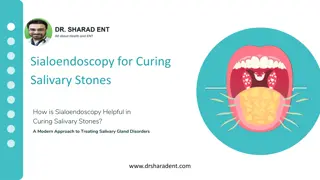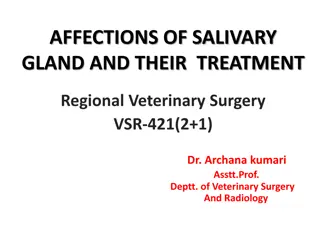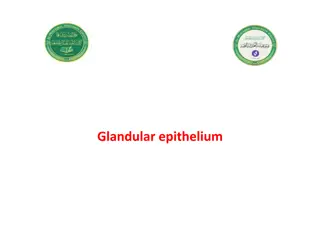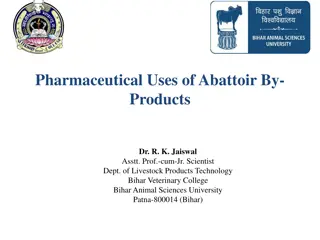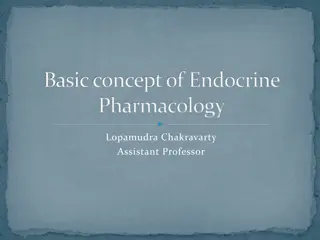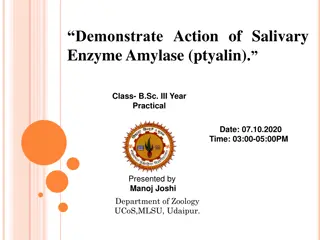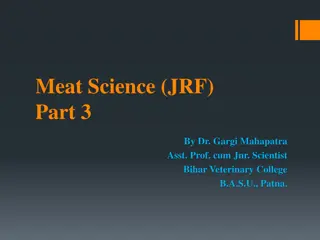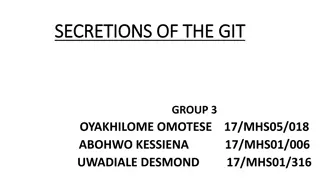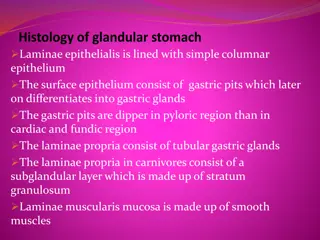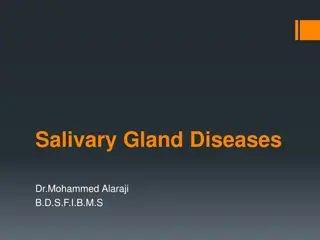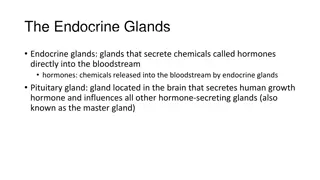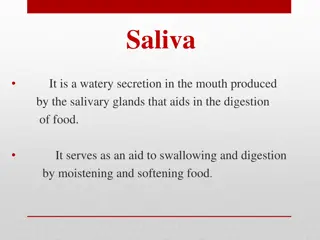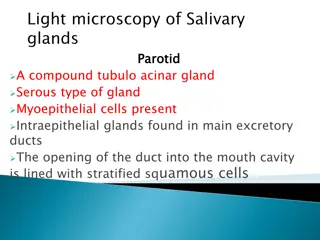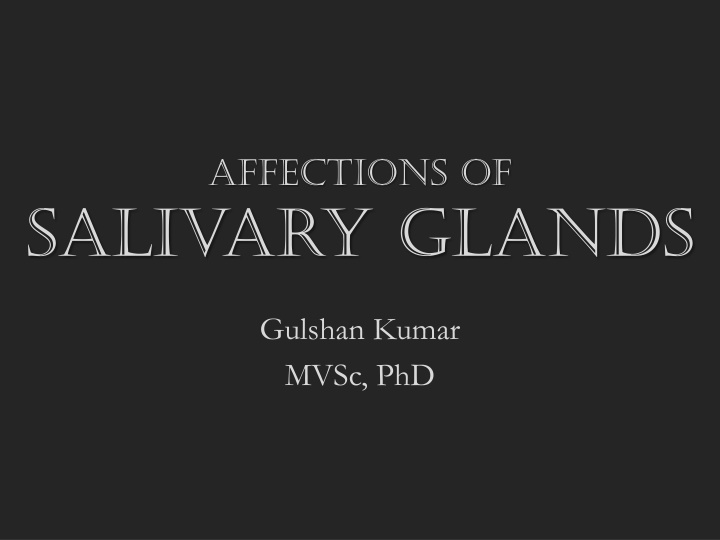
Salivary Glands Affections and Treatment Overview
Explore congenital and acquired affections of the salivary glands, including salivary fistula, foreign bodies, and calculi. Learn about causes, symptoms, and treatment options for these conditions to maintain optimal oral health.
Download Presentation

Please find below an Image/Link to download the presentation.
The content on the website is provided AS IS for your information and personal use only. It may not be sold, licensed, or shared on other websites without obtaining consent from the author. If you encounter any issues during the download, it is possible that the publisher has removed the file from their server.
You are allowed to download the files provided on this website for personal or commercial use, subject to the condition that they are used lawfully. All files are the property of their respective owners.
The content on the website is provided AS IS for your information and personal use only. It may not be sold, licensed, or shared on other websites without obtaining consent from the author.
E N D
Presentation Transcript
Affections of Salivary Glands Gulshan Kumar MVSc, PhD
Affection of salivary glands Salivary glands affection can be divided into 2 types:- congenital and acquired. A-Congenital:- resulting in a fluid-filled swelling proximal to the obstruction site. Associated with agenesis or atresia of the parotid ducts,
B-Acquired:- Trauma: (Open Wounds) The saliva escapes through the wound. Haemostasis is to be done. Fresh wound must be sutured after thorough cleaning and debridement. Stensen s duct may be damaged. During feeding, there is copious discharge of saliva from the wound. More difficult to obtain healing of the lesion on the duct than in the gland (greater amount of saliva flows through the opening in the canal). Perforate the cheek at the level of the wound, when the latter is near the mouth, to provide another passage for the saliva (for healing by first intention). Suture the cutaneous wound. Avoid any solid food for 24 hrs, in order not to excite salivation.
B-Acquired:- Salivary Fistula: A permanent fistula may result after wounding of salivary duct by accident or after operation. It may be due to a wound of the parotid, or submaxillary, salivary gland or of Stensen s duct or Wharton s duct, or an abscess involving the canal. If the fistula has been in existence for some time, cauterization of its edges or freshening is done, after which it should be sutured. The fistulous tract has usually a form of a fibrous tube. Dissect around the fibrous wall and cut it close to the salivary duct, introduce a polyethylene catheter into the duct, secure the end in the mouth with few sutures and in the neck and cut off the excess. Close the wound. (cauterise with AgNO3 or freshen+purse string) The catheter facilitates normal drainage of saliva.
B-Acquired:- Foreign bodies in the salivary ducts: Small particles may enter into salivary glands and set up inflammation. Foreign bodies are rare, may cause irritation and form a calculus. To remove the foreign body, give pressure on the course of the duct otherwise, oral orifice of the canal may be incised. Apply antiseptic mouth lotion for a few days.
B-Acquired:- Salivary calculi: Usually occur in Stensen s duct; rarely in Wharton s duct. The size of calculi varies, they are usually small but exceptional cases of concretions weighing individually 7-12 ounces have been recorded. Oval; smooth and yellowish-grey in colour. The calculi are 80-90% calcium carbonate and 9-10% organic matter. Small particles carrying bacteria may gain entry into the duct, which cause fermentation in the saliva and consequently deposition of lime on the foreign body. Treatment involves forcing the calculus into the mouth and then removing it. If it bulges into the oral cavity, incise the mucus membrane covering the calculus and remove it. Suture the wounds in the duct and skin separately using a very fine needle.
B-Acquired:- Tumors: The common tumors are melanomata, (found chiefly in grey horses). If benign and circumscribed, surgical excision is carried out. If it is malignant or diffuse, it is better not to interfere. Parotid abscess: Strangles in the horse and tuberculosis in the ox may cause an abscess in subparotid region (a painful inflammatory swelling). May burst in 8-14 days. Treatment- open the abscess and drain the contents. It may be possible to open the abscess bluntly after incising the skin. Suitable antiseptic dressing and systemic antibiotic.
B-Acquired:- Tumors: Salivary mucocele (Ranula): Obstruction of the salivary duct leads to dilation of the duct and formation of a salivary cyst. Collection and accumulation of saliva surrounded by granulation tissue. Often noted as a fluctuant, painless swelling of the neck or within the oral cavity or subcutaneously. Diagnosis- Symptoms and exploratory puncture. Treatment consists of establishment of the patency of the duct. The affected salivary gland may be excised or destroyed.


